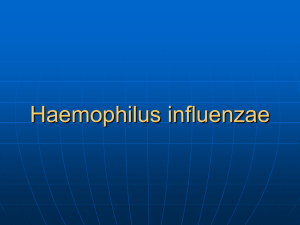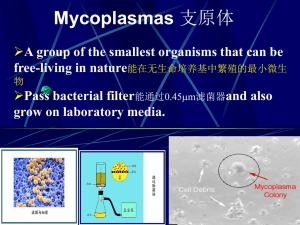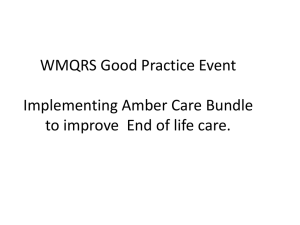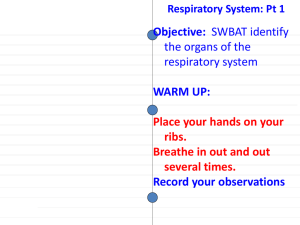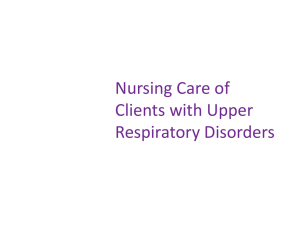MICR 201 Microbiology for Health Related Sciences
advertisement
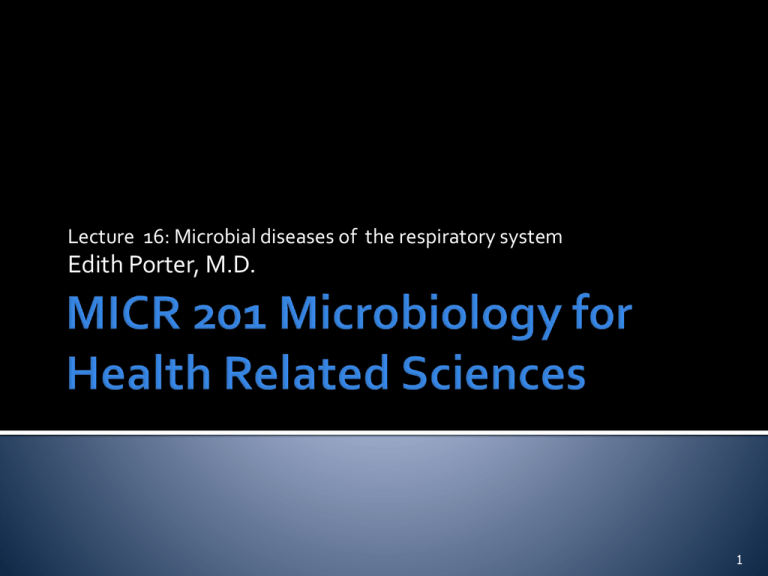
Lecture 16: Microbial diseases of the respiratory system Edith Porter, M.D. 1 Respiratory systems: structure and normal microbiota Upper respiratory tract infections General: pharyngitis, tonsillitis, laryngitis, sinusitis, epiglottitis, otitis media Bacterial diseases Viral diseases Lower respiratory tract infections General: bronchitis, bronchioliis, pneumonia Bacterial diseases Viral diseases Fungal diseases 2 3 4 Upper respiratory tract Nasooropharynx Gram+ Gram- anaerobes Neisseria spec. a-hemolytic streptococci Haemophilus spec. Lower respiratory tract Mucociliary escalator Scarcely populated 5 Laryngitis: S. pneumoniae, S. pyogenes, viruses Tonsillitis: S. pyogenes, S. pneumoniae, viruses Sinusitis: Bacteria, fungi Epiglottitis: H. influenzae Sinusitis in right maxillary sinus in a CT scan (Ilana Seligman) 6 7 More common in young children Small auditory tube which connects middle ear and throat 50% of all office visits to pediatrician S. pneumoniae (35%) H. influenzae (20-30%) M. catarrhalis (10-15%) S. pyogenes (8-10%) S. aureus (1-2%) Incidence of S. pneumoniae reduced by vaccineby 6 – 7% 8 Streptococcus pyogenes Group A streptococci Resistant to phagocytosis Streptokinases lyse clots Streptolysins are cytotoxic Diagnosis indirect agglutination ELISA 9 Streptococcus pyogenes Pharyngitis + exanthem Erythrogenic toxin produced by lysogenized S. pyogenes Tongue strawberry like 10 Corynebacterium diphtheriae Gram-positive rod, pleomorphic Diphtheria (Greek: leather) membrane forms in throat fibrin, dead tissue, and bacteria Diphtheria toxin produced by lysogenized C. diphtheriae Blocks protein biosynthesis Infection is local but toxin may spread systemically Kidney failure, heart failure Prevented by DTaP and Td vaccine (Diphtheria toxoid) 11 12 13 Over 200 different viruses capable of causing common cold Rhinoviruses (50%, over 100 serotypes) A single virus attached to mucosa might be sufficient to cause a cold Coronaviruses (15-20%) Less frequent in older people Possibly accumulated immunity Duration ~1 week With remedies ~ 7 days 14 Bacteria, viruses, & fungi cause: Bronchitis Bronchiolitis Pneumonia 15 16 17 Bordetella pertussis Gram-negative coccobacillus Capsule Numerous toxins and pathogenic factors Tracheal cytotoxin ▪ Selective damages ciliated respiratory cells ▪ Local action Pertussis toxin ▪ Overstimulates cells leading to dysfunction ▪ Locall + systemic action 18 Stage 1: Catarrhal stage, like common cold Stage 2: Paroxysmal stage: Violent coughing sieges Stage 3: Convalescence http://www.vaccineinformation.org/photos/pert_wi001.jpg stage 19 Major complications most common among infants and young children Include hypoxia, apnea, pneumonia, seizures, encephalopathy, and malnutrition Young children can die from pertussis Most deaths occur among unvaccinated children or children too young to be vaccinated Prevented by DTaP vaccine (acellular Pertussis cell fragments) 20 21 22 Mycobacteria Acid-fast rods Lipid rich cell wall M. tuberculosis Primary cause Transmitted from human to human 20 h generation time: slow growth M. bovis <1% U.S. cases not transmitted from human to human Attenuated strain used in BCG vaccine M. avium-intracellulare complex infects people with late stage HIV infection Faster growing 23 24 Bad cough over 3 weeks Sputum production Thick, viscous Later on blood stained Weight loss Night sweat Weakness or fatigue Evening lower grade temperature or chills 25 Airborne Infection 90 % 10 % Latent TB TB Disease No symptoms Not sick Cannot spread disease Chest X Ray and sputum are normal Symptoms Can spread infection Positive skin test Possible abnormal chest X ray Positive sputum smear or culture Dissemination AIDS increases susceptibility Reactivation (secondary) TB Untreated: Severe illness, Death 26 Diagnosis: Tuberculin skin test screening + = current or previous infection Followed by X-ray or CT, acid-fast staining of sputum, culturing bacteria, PCR 27 Prolonged treatment with multiple drugs 6 months at least Combinantion Pronounced side effects Vaccines BCG, live, avirulent M. bovis Not widely used in U.S. 28 Streptococcus pneumoniae Gram-positive encapsulated diplococci Over 90 serotypes Symptoms High fever Difficulty breathing Chest pain Diagnosis by culturing bacteria 29 Mycoplasma pneumoniae Pleomorphic Bacteria without a cell wall Require cholesterol for growth “Fried egg” appearance on agar media Also called primary atypical pneumonia and walking pneumonia Common in children and young adults Diagnosis by PCR or by IgM antibodies 30 Coxiella burnetii Obligate intracellular bacterium Flulike pneumonia High fever Headache Muscle ache Coughing Long recovery 2% may develop endocarditis 60% of all infections asymptomatic Reservoir: cattle Infection via aerosol or ingestion of unpasteurized milk 31 Viral pneumonia as a complication of influenza, measles, chickenpox Viral etiology suspected if no other cause determined Respiratory Syncytial Virus (RSV) Common in infants; 4500 deaths annually Causes cell fusion (syncytium) in cell culture Symptoms: coughing Diagnosis by serologic test for viruses and antibodies 32 Chills, fever, headache, muscle aches (no intestinal symptoms) 1% mortality due to secondary bacterial infections Vaccine for high-risk individuals 33 Segmented RNA virus 8 separate segments Enveloped Hemagglutinin (H) spikes used for attachment to host cells Neuraminidase (N) spikes used to release virus from cell 34 Antigenic drift No proof reading of RNA polymerase Mutations in genes encoding H or N spikes May involve only 1 amino acid Allows virus to avoid mucosal IgA antibodies Antigenic shift Changes in H and N spikes Probably due to genetic recombination between different strains infecting the same cell Causes pandemic 1918/1919: over 20,000,000 deaths world wide 35 37 Direct antigen detection with nasal swabs Cell culture and PCR 38 Histoplasmosis Eastern US Tb like symptoms but tuberculin negative Can spread throughout the body Coccidioidomycosis: Southwestern US Increased incidences after natural disasters, e.g. earthquakes Pneumocystis Associated with immunodificiency e.g. AIDS Pneumonia with dry strong and prolonged cough 39 Respiratory systems: structure and normal microbiota Upper respiratory tract infections General: pharyngitis, tonsillitis, laryngitis, sinusitis, epiglottitis, otitis media Bacterial diseases: strep throat, scarlet fever, dipheteria, Viral diseases: Common cold Lower respiratory tract infections General: bronchitis, bronchiolitis, pneumonia Bacterial diseases: pneumonia (lobar, atypical), tuberculosis Viral diseases: influenza, RSV Fungal diseases: histoplasmosis, coccidiomycosis, pneumocystis 40 1) Which of the following does NOT confirm a diagnosis of strep throat? A) Hemolytic reaction B) Bacitracin inhibition C) Symptoms D) Serological tests E) Gram stain 2) Which of the following pairs is mismatched? A) Epiglottitis – Haemophilus B) Q fever – Rickettsia C) Diphteria - Corynebacterium D) Whooping cough – Bordetella E) All are correct 3) The recurrence of influenza epidemics is due to A) Lack of antiviral drugs. B) The Guillain-Barré syndrome. C) Antigenic shift. D) Lack of naturally acquired active immunity. E) HA spikes. 41


